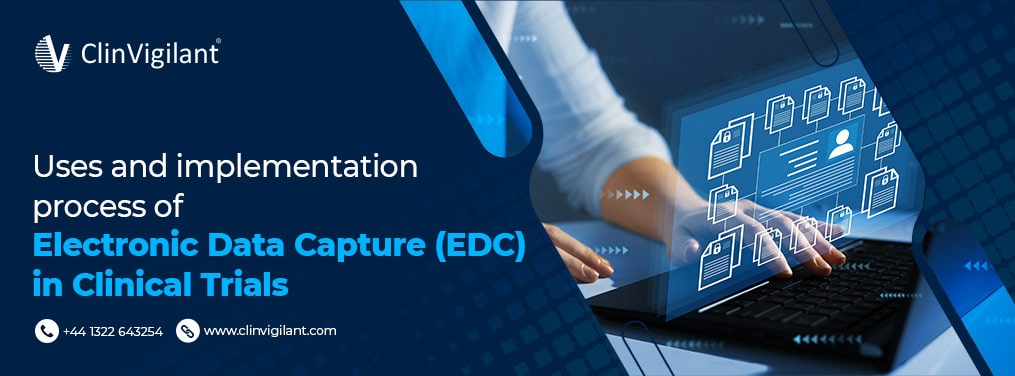
Clinical trials are critical in determining the safety and efficacy of new treatments, therapies, and medical interventions in modern medicine. The traditional pen-and-paper technique to data collecting in clinical trials, on the other hand, is time-consuming, error-prone, and can result in inefficiencies. Enter Electronic Data Capture (EDC), a game-changing tool that has altered the clinical research field. This article delves into the applications and implementation of EDC in clinical trials, providing light on its numerous benefits and the procedures necessary in its seamless integration.
Understanding EDC in Clinical Trials:
Electronic Data Capture (EDC) is a game-changing tool used in clinical trials to gather, organize, and store data digitally. It uses electronic case report forms (eCRFs) to replace traditional paper-based data-collecting techniques. EDC simplifies the process of recording critical information regarding participants, treatments, and results, resulting in several benefits. EDC ensures data accuracy and quality with built-in validation tests, reducing errors frequently occurring during human data entry.
Researchers and stakeholders can monitor trial progress and safety in real-time, allowing for fast interventions if necessary. The digital nature of EDC speeds up data administration, saving time and money over labor-intensive paper-based solutions. Furthermore, by incorporating features that correspond to industry rules and privacy regulations, it encourages regulatory compliance. Overall, EDC improves clinical trial data’s efficiency, precision, and reliability, allowing for more informed judgments and furthering medical research.
Key Benefits of EDC in Clinical Trials:
The integration of cutting-edge technologies has transformed several elements of medical research in the changing terrain of modern healthcare. eCRF in clinical trials is one such disruptive invention that has changed the way clinical trials are conducted. This advanced technology has improved clinical trial productivity, accuracy, and overall outcomes by replacing traditional paper-based data collection methods with digital technologies. In this section, we will look at the primary benefits of EDC in clinical trials and how this technology impacts the future of medical research.
1. Enhanced Data Accuracy and Quality:
The integration of cutting-edge technologies has transformed several elements of medical research in the changing terrain of modern healthcare. Electronic data capture (EDC) is one such disruptive invention that has changed the way clinical trials are conducted. This advanced technology has improved clinical trial productivity, accuracy, and overall outcomes by replacing traditional paper-based data collection methods with digital technologies. In this section, we will look at the primary benefits of EDC in clinical trials and how this technology impacts the future of medical research.
2. Real-time Data Access and Monitoring:
The capacity to access and analyze trial data in real-time is one of EDC’s distinguishing features. Remote access to up-to-date information about participant enrollment, treatment regimens, and adverse events is available to researchers, doctors, and sponsors. This real-time monitoring enables stakeholders to make rapid decisions, intervene quickly in the event of safety concerns, and alter trial protocols as needed, thereby contributing to participant safety and trial success.
3. Efficient Data Management and Query Resolution:
EDC simplifies data administration by automating data entry, storage, and retrieval operations. It also makes query administration easier by allowing researchers to build and resolve data queries online. This reduces the need for human correspondence between sites and sponsors, resulting in faster resolution of disputes and more complete data.
4. Cost and Time Savings:
Transitioning from traditional paper-based procedures to EDC can save both money and time. Automating data collection and administration reduces the administrative load associated with human data entry, data reconciliation, and query resolution. This results in shorter trial lengths, faster data analysis, and lower operational expenses.
5. Improved Regulatory Compliance:
EDC systems are developed to comply with industry regulations by adhering to Good Clinical Practice (GCP) principles and regulatory norms. These systems include audit trails, data security measures, and user access controls, which improve data integrity while adhering to the highest ethical and legal standards throughout the trial process.
6. Streamlined Collaboration and Communication:
EDC enables easy collaboration among multidisciplinary clinical trial teams. Researchers, physicians, data managers, and sponsors can all use and contribute to the same digital platform, allowing for more effective communication, data sharing, and decision-making. This collaborative approach promotes transparency and expedites the trial’s progress.
7. Simplified Data Analysis and Reporting:
EDC systems generate structured and ordered datasets, which speed up the data analysis and reporting process. Researchers can extract, process, and load data into statistical analysis software, allowing them to produce study reports, regulatory filings, and publications more quickly.
Implementation Process of EDC in Clinical Trials
Incorporating Electronic Data Capture (EDC) technology into the clinical trial process represents a revolutionary departure from old paper-based procedures. This simplified approach improves data accuracy, real-time monitoring, and trial efficiency. The following steps outline the process of applying EDC in clinical trials:
1. Protocol Development and Study Design:
The journey starts with the development of the clinical trial protocol. The aims of the study, eligibility criteria, endpoints, and data collection requirements are all outlined by the researchers. The EDC implementation adheres to certain protocol criteria to ensure accurate and thorough data acquisition.
2. EDC System Selection:
It is critical to select the best EDC system. Trial complexity, data volume, user-friendliness, security features, and integration possibilities with other clinical trial systems are all considered. Choosing an EDC system that meets the trial’s requirements lays the groundwork for effective implementation.
3. Database Design and Configuration:
The EDC database is designed to match the study protocol throughout this phase. There are defined data entry fields, validation rules, skip patterns, and user roles and permissions. The database is set up to capture all relevant information while maintaining data accuracy and integrity.
4. Electronic Case Report Form (eCRF) Development:
Electronic Case Report Forms (eCRFs) are electronic versions of traditional paper CRFs. These forms have user-friendly interfaces to allow for efficient data entry. Logic checks are used to prevent errors and provide consistent data collecting across sites.
5. User Training:
Stakeholders such as investigators, site employees, and data managers receive extensive training on how to use the EDC system. Data entry, query resolution, adverse event reporting, and navigating the system’s interface are all covered in training.
6. Site Initiation:
Clinical trial locations are established once the participants have been trained. Sites are granted access to the EDC system and can begin enrolling members. According to the study protocol, data obtained, such as demographic information, medical history, and treatment details, are entered into the eCRFs.
7. Data Collection and Monitoring:
Site employees meticulously enter participant data into the EDC system during the experiment. Sponsors, monitors, and investigators have real-time access to the data, allowing them to track progress, spot trends, and respond to issues as they arise.
8. Data Cleaning and Quality Assurance:
Routine cleaning and quality assurance checks are done as data accumulates. Data validation tests are frequently automated in EDC systems to detect errors and inconsistencies. Any differences are highlighted, and queries are issued to correct any errors.
9. Database Lock and Analysis:
The database is locked to prevent future changes when all data has been input, cleaned, and confirmed. The locked dataset is exported for statistical analysis, in which researchers assess the trial’s outcomes and draw conclusions based on the data obtained.
10. Regulatory Submissions and Reporting:
Electronic Data Capture systems make it easier to generate regulatory submissions. The system’s structured and organized data may be easily integrated into regulatory filings, study reports, and publications, saving time and ensuring correctness.
Conclusion:
The adoption of Electronic Data Capture (EDC) technology has transformed the clinical trial scene by simplifying data collecting, improving accuracy, and eliminating inefficiencies. EDC provides numerous benefits to all parties participating in clinical research, ranging from real-time data access and increased participant safety to efficient data management and cost savings. As the healthcare industry evolves, using EDC systems will become standard practice, ensuring that clinical trials remain at the forefront of scientific development while maintaining the highest data integrity and patient safety standards.

